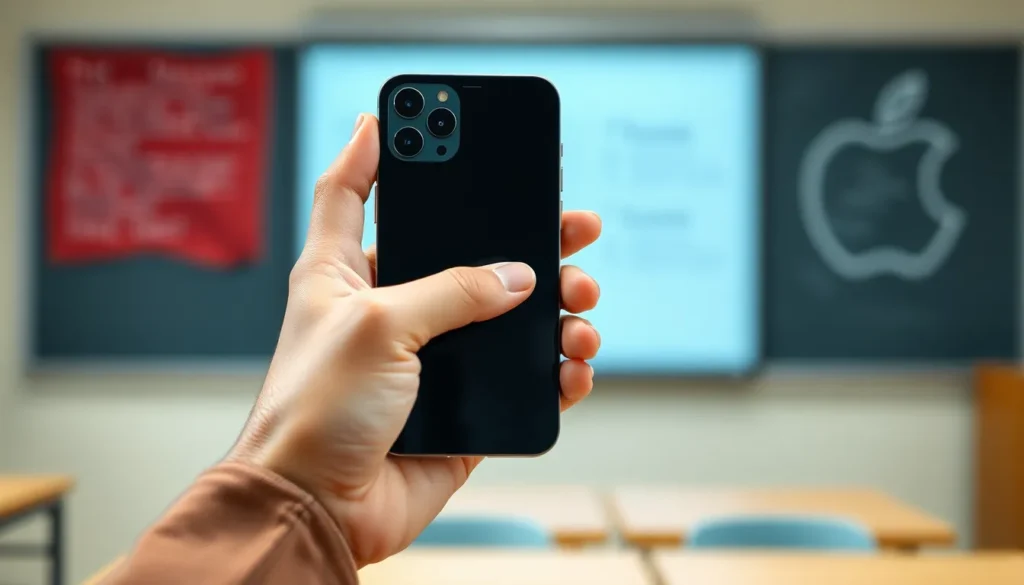Table of Contents
TogglePicture this: you’re in a meeting, trying to impress your boss, and suddenly your phone rings louder than a rock concert. Awkward, right? Enter the iPhone 14’s vibrate feature, your secret weapon for staying discreet while still being connected. Whether you’re dodging distractions or just want to keep your phone on the down-low, knowing how to turn vibrate on is essential.
Understanding Vibrate Functionality
Vibrate functionality on the iPhone 14 plays a crucial role in enhancing user experience. This feature enables users to remain discreet and focused in various environments.
Importance of Vibrate Mode
Vibrate mode allows users to receive notifications without creating disturbances. Maintaining silence during meetings or quiet events becomes easier with this feature. Device vibrations provide subtle alerts, ensuring users stay connected without interrupting others. Knowing how to access and use this functionality enhances etiquette and respect in public settings. Users can appreciate the balance between connectivity and consideration.
Use Cases for Vibrate Mode
Vibrate mode proves beneficial in various scenarios. During meetings, it helps users avoid distractions caused by ringing notifications. In classrooms, vibration alerts allow students to stay informed without disrupting lectures. Users benefit from vibrate functionality while exercising, as it enables notifications without needing to check the device frequently. Quiet environments like theaters or libraries also remind users to stay aware of calls and messages discreetly. Ensuring that vibrate mode is activated in these situations fosters a culture of respect and attention.
How to Access Settings

Accessing settings on the iPhone 14 is straightforward. Users quickly find the desired configuration for vibrate mode by following a few simple steps.
Locating the Settings App
Finding the Settings app is easy. It often appears as a gear icon on the home screen. Users can also swipe down on the screen to open Spotlight Search and type “Settings.” This method quickly leads to the app, allowing users to access system preferences without navigating through multiple screens.
Navigating to Sounds & Haptics
Once in Settings, the next step involves locating the Sounds & Haptics option. Scrolling down reveals this choice in the list of available settings. Tapping on Sounds & Haptics opens the relevant menu, where users can manage various options, including vibrate settings. From here, it’s possible to enable or adjust the vibrate functionality for calls, notifications, and alerts depending on user preference.
Steps to Turn On Vibrate
Turning on vibrate mode on the iPhone 14 is straightforward. Users can easily manage their preferences in just a few steps.
Enabling Vibrate on Ring Mode
First, open the Settings app by tapping the gear icon. Next, navigate to Sounds & Haptics. Toggle on the switch for Vibrate on Ring. This setting allows the device to vibrate when a call comes in while it remains in ring mode. Users can now stay discreet during meetings or other quiet situations. Additionally, adjusting the ringer volume ensures that notifications can be both audible and tactile.
Enabling Vibrate on Silent Mode
To activate vibrate in silent mode, follow similar steps. Open the Settings app and proceed to Sounds & Haptics. Look for the option labeled Vibrate on Silent and toggle it on. This feature ensures that the phone vibrates for calls and notifications even when set to silent. Keeping it activated allows for additional discretion in scenarios like theaters and libraries. Users appreciate receiving alerts without causing disturbances in quiet settings.
Troubleshooting Vibrate Issues
Vibrate issues can disrupt the intended functionality of the iPhone 14. Identifying common problems can help users address these concerns effectively.
Common Problems with Vibrate
Users often encounter several issues with the vibrate feature. One common problem is accidental toggling of the mute switch, which disables both ring and vibrate modes. Not receiving vibrations during incoming calls or notifications occurs frequently when settings aren’t configured correctly. System updates sometimes affect vibrate functions, leading to unexpected behavior. Battery-saving modes can also impact vibrate performance, especially if enabled inadvertently.
Solutions for Vibrate Not Working
Fixing vibrate issues typically involves several straightforward solutions. First, check the mute switch on the side of the iPhone 14 to ensure it isn’t in the silent position. Second, navigate to Settings, then Sounds & Haptics, and confirm that both “Vibrate on Ring” and “Vibrate on Silent” are activated. Restarting the device can also resolve temporary glitches that might affect vibrate functionality. Lastly, uninstall any recently installed applications that could interfere with the vibrate settings.
Mastering the vibrate feature on the iPhone 14 is essential for maintaining focus and respect in various environments. With simple steps to activate and customize vibrate settings users can enjoy a seamless experience while staying informed.
By ensuring the vibrate mode is properly configured users can avoid distractions and remain considerate of those around them. Troubleshooting tips further enhance the functionality of this feature allowing users to resolve any issues that may arise.
Embracing the vibrate mode not only improves personal convenience but also fosters a culture of mindfulness in shared spaces.







